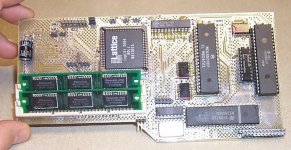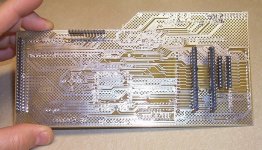NoCan, the 6551 version
NoCan2, the 16550 version
Presented by:
Only On Saturday Night
And here it is. NoCan2 (16550 version). The photo shows a 16450, MC68B09EP
& a HD63B21P (PIA), just for first time power-up. Those pink wires
on the 3 buffers, 74ACT245's were used, wired to act like '541's, pinout
is almost exactly the same.
Flash:
Tuesday, June 1, It booted NitrOS-9, in the 4MHz mode, from RS-DOS. Used
daily in the 4MHz mode. The "4MHz" frequency that is spliced in, is actually
about 4.77MHz. The "4MHz" throughput is still about 4MHz, no different
than SockMaster.
Top View: topview2.jpg - 950x490
Bottom View: botview2.jpg - 1008x578
Pin View: pinview1.jpg - 1098x348
Installed: smle1txt.jpg -1009x254




This NoCan2 board has:
-
2-megs of memory, fully useable for OS9 or NitrOS-9.
-
Uses 3 or 8 or 9 chip, 1MB or 4MB SIMM's, doesn't care.
-
Auto-Refreshing of the SIMM's.
-
Only gives 2MB even though 4MB SIMMs can be used.
-
4MHz, can be turned off if not needed or wanted.
-
For 63x09E's only. Doesn't seem to work with 68x09E's.
-
Probably will not work in the 4MHz mode with any 32MHz crystal hack.
-
The Lattice chip will work up to 80MHz.
-
The bottleneck is the CPU.
-
1 serial, a 16550. Actually, 8250, 82C450, 16450, 16550's have been tried.
-
1 parallel, a 6821 PIA, wired as a printer port.
-
Full CPU address & R/W buffers.
-
The buffers connect back to the coco-3 and to the coco-3 game slot, and
-
E & R/W are buffered separately on this board.
NoCan fits over the top of the metal can and plugs into the coco-3 similar
to RamZilla. The serial and parallel ports can
be address selected similar to RamZilla.
6821:
Is set up like a printer port. Use the /PiaPak driver and /Lpt1 descriptor,
or you can write your own drivers. Has a DB-25 cable header, for a DB-25F
connector, just like a PC. It can be used as a bi-directional 8-bit port,
with the appropriate software.
16550: (NoCan2 only)
The 6821 has jumpers to select either $FF6X or $FF7X, while the 16550
has jumpers to select either $FF1X or $FF3X
address range. I have no buffered software drivers for this 16550 serial
port chip, don't ask. I do have a very crude serial port driver and descriptor.
Reads or writes a byte at a time, no interrupts acknowledged, tested with
8250, 82C450, 16450, 16550.
6551: (NoCan only)
The 6551 has jumpers to select the addresses
for the 6551 and the 6821. There are several software drivers, at other
sites, for this chip.For the serial port, (6551 or 16550) there is a MAX232
buffer and a DB-9 header, along with a place for a 1.8432MHz oscillator
can. Only TXD, RXD, RTS and CTS are connected to the MAX232 and then to
the DB-9 header. Use a standard PC-DB9 header cable.
The serial and parallel selection. Set jumpers for your desired
address range. Jumpers are designed so that both chips can't be on
the same address.
4MHz:
For the 4MHz, there are headers for green and yellow low-power LED's
(suggested colors). One LED lights up when it's in the POKE &HFFD9
(fast) mode, other LED lights up when it is actually running the 4MHz.
Also, there's a 2-pin header for the external switch that the user can
toggle, turning 4MHz on or off.
NoCan, the name comes from the
idea that some folks have removed their RF metal-can and therefore would
be able to use this board with shorter connections, ie. shorter pins.
|
NoCan2 Rev E1 Preliminary VHDL
|





